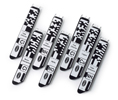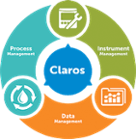-
Products
- Lab Instruments
-
Lab Meters and Probes
- Chemistries, Reagents, and Standards
-
Online Analyzers
Ammonium Analysers Ammonia Monochloramine Analyzers Chlorine Analyzers
- CL17sc
- CL10sc Amperometric
- Ultra Low Range CL17sc Colorimetric Chlorine Analyser
- RMC Disinfection Panel
EZ Series Analysers- Iron
- Aluminium
- Manganese
- Phosphate
- Chloride
- Cyanide
- Fluoride
- Sulphate
- Sulphide
- Arsenic
- Chromium
- Copper
- Nickel
- Zinc
- Ammonium
- Total Nitrogen
- Phenol
- Volatile Fatty Acids
- Alkalinity
- ATP
- Hardness
- Toxicity
- Sample Preconditioning
- Boron
- Colour
- Nitrate
- Nitrite
- Silica
- Hydrogen Peroxide
- EZ Series Reagents
- EZ Series Accessories
- EZ sc Series Inorganics
- EZ sc Series Metals
- EZ sc Series Nutrients
- Flow and Collections
-
Online Sensors and Controllers
Digital Controllers (Transmitters) Ammonium SensorspH & ORP Sensors
- 12mm pH/ORP
- 8362 sc High Purity
- Combination pH/ORP
- Differential pH
- Digital Differential ORP
- Digital Differential pH
- LCP ORP
- LCP pH
Conductivity Sensors- 3400 Analogue Contacting
- 3400 Digital Contacting
- 3700 Analogue Inductive
- 3700 Digital Inductive
- 9523 Cation Conductivity
- Samplers
- Claros Water Intelligence System
- Test Kits & Strips
-
Microbiology
Accessories and Chemicals Dehydrated MediaLabware
- Accessories
- Funnels, Pumps & Manifolds
- Microbiology Filters
- Petri Dishes & Accessories
- Sampling Bags
- Vials, Tubes, Bottles & Racks
-
Lab Equipment and Supply
Apparatus
- Brushes
- Clamps, Rings & Stands
- Crucibles
- Crucibles & Casseroles
- Dispensers & Droppers
- Grab Samplers
- Oil and Grease
- Other Apparatus
- Pipet Aids
- Pipettes
- Racks
- Stir Bars
- Tubing
- Weighing Accessories
General Lab Consumables Glassware/PlasticwareInstruments Safety Equipment - Industrial UV
- Electrochemistry
- Parameters
- Industries
- Support
- Service
- e-Shop
- Brands
Hach New Zealand
Choose your country or region:
Europe
Americas
Asia - Australasia
- Australia
- Mainland China
- India
- Indonesia
- Japan
- Malaysia
- New Zealand
- Philippines
- Singapore
- South Korea
- Thailand (Thai)
- Taiwan
- Vietnam
Middle East - Africa
Prices Online Include GST 0800 50 55 66
Nitrate & Nitrite
What are Nitrates and Nitrites?
Nitrate and nitrite are compounds that contain nitrogen and oxygen. Both nitrate and nitrite molecules contain one nitrogen atom. Nitrites have two oxygen atoms, while nitrates have three oxygen atoms.
Nitrate
Nitrate represents a more oxidized state of nitrogen. Autotrophic bacteria convert ammonia into nitrite and then into nitrate under aerobic conditions; lightning converts large amounts of atmospheric nitrogen (N 2) directly to nitrate. The bacterial reduction of nitrate can also produce nitrite under anaerobic conditions.
Nitrite
Nitrite nitrogen occurs as an intermediate stage in the biological decomposition of ammonia/ammonium. Autotrophic bacteria convert ammonia under oxic (aerobic) conditions to nitrates.
Nitrification and Denitrification
This process happens naturally in lakes, rivers and other aqueous and natural environments. These biological processes are commonly applied in wastewater treatment or biofiltration for nitrogen removal. Nitrification may occur in drinking water distribution systems where it is unwanted and should be monitored closely.
Nitrification is the two-step aerobic biological oxidation of ammonia to nitrite and finally nitrate. Denitrification is a microbially facilitated process during which nitrate is reduced anoxically to produce molecular nitrogen as the final step.
In these processes, different conditions in oxic (aerobic) and anoxic zones of wastewater treatment are used by autotrophic bacteria such as nitrosomonas, or heterotrophic bacteria such as nitrobacter to convert ammonia, nitrate, and nitrate to nitrogen gas. Oxygen control is critical to nitrification among other important factors such as alkalinity. Dissolved oxygen (DO) must be monitored and managed during this process. Effective denitrification relies on the lack of DO and an appropriate amount of readily degradable carbon.
Why Measure Nitrate and Nitrite?
As an integral part of the nitrogen cycle in the environment, nitrite and nitrate are nutrients and a vital source of nitrogen for plants and the complex organisms that consume them. Composed of oxygen and nitrogen, the nitrate ion occurs naturally in soil. Because nitrites readily oxidize to nitrates, they are not often found in surface waters.
When concentrations are adequately monitored and maintained, nitrite and nitrate play an important role in many industrial and municipal water-quality monitoring programs:
- Nitrites are often used as corrosion inhibitors in industrial process water and cooling towers.
- The food industry uses nitrite compounds as preservatives.
- Many granular commercial fertilizers contain nitrogen in the form of nitrates.
Excessive nitrite and nitrate concentrations can negatively affect water treatment processes and pose health risks:
- High levels of nitrate in water may indicate biological wastes in the final stages of stabilization or run-off from heavily fertilized fields.
- Nitrate-rich effluents discharged into receiving waters can degrade water quality by encouraging the excessive growth of algae.
- Drinking waters containing excessive amounts of nitrates (MCL = 10 mg/L) can cause infant methemoglobinemia (blue babies), while nitrite concentrations seldom exceed 0.1 mg/L.
Nitrite and nitrate concentrations can negatively affect wastewater treatment processes and pose health risks:
- Nitrates cause a degradation in systems that maintain biological phosphorus removal by fouling anaerobic zone conditions.
- Chlorine disinfection system effectiveness is reduced by the presence of nitrite.
- Total inorganic nitrogen (TIN) content in wastewater effluent contributes to receiving water quality degradation.
At Hach ®, find the testing equipment, resources, training, and software you need to successfully monitor and manage nitrite and nitrate levels in your specific process application.
Featured Products to Measure Nitrate and Nitrite
NT3 Series UV Nitrate and Nitrite Sensors
Hach’s NT3100sc UV Nitrate and NT3200sc UV Nitrate and Nitrite Sensors provides high accuracy, simple maintenance and dual parameter capability.
Shop NowHach's digital ion-selective N-ISE sc probe is designed for the determination of nitrate concentration directly in the medium.
Shop NowThe EZ Series Online Analyzers offer multiple options to monitor nitrate in water.
Shop NowThe EZ Series Online Analyzers offer multiple options to monitor nitrite in water.
Shop NowThe DR3900 and DR6000 benchtop spectrophotometers provide reliable, accurate measurements time after time.
Shop NowWhether you are looking for a single parameter testing device such as the DR300, or a sophisticated hassle-free instrument that can measure up to 90 methods like the DR900, we have a solution.
Shop NowHQ440D Laboratory Nitrate (NO₃⁻) Ion Meter Package with ISENO3181 Ion Selective Electrode
The Hach HQ440D Laboratory Multi-Meter is an advanced laboratory meter that takes the guesswork out of measurements.
Shop NowThe HQ Series is for water quality professionals who want to perform electrochemical analysis for field and lab environments.
Shop NowHach is dedicated to providing high-quality reagents for routine and challenging water analysis.
Shop NowHach is dedicated to providing high-quality reagents for routine and challenging water analysis.
Shop Now
Which Processes Require Nitrate/Nitrite Monitoring?
Wastewater Treatment
In wastewater systems where specific forms of nitrogen are limited in permits or systems where monitoring is required, nitrite and nitrate concentrations through the system should be understood.
Systems that are required to monitor effluent total nitrogen (TN), total inorganic nitrogen (TIN) or NOx should sample for nitrite (NO 2 -) and nitrate (NO 3 -) at important locations thought the plant.
Nitrification and denitrification efficiency and stability depends on many factors: proper pH, alkalinity, dissolved oxygen (DO), temperature, available carbon, solids retention time (SRT), internal mixed liquor recycle rates (IMLR), and anoxic conditions among other factors for each respective biological system.
Nitrogen enters wastewater plants as ammonia (NH 3) or ammonium (NH 4 +) and is removed by biological treatment processes. Typical ammonia nitrogen levels in raw municipal influent ranges from 30 mg/L - 50 mg/L NH 3 -N. Nitrate levels indicate the stage of conversion of ammonia and organic nitrogen forms to nitrate by the aerobic biological treatment steps during nitrification.
Nitrification converts ammonia/ammonium to nitrate in an oxic condition with a stable population of nitrifying bacteria, proper oxygen (DO), alkalinity, pH, temperature and solids retention time (SRT).
Denitrification converts nitrate ultimately to nitrogen gas (N 2) where it’s removed from the system in an anoxic condition with adequate readily biodegradable carbon, proper detention time, temperature and void of free oxygen (DO). If the system has an internal recycle (IR or IMLR) to aid in denitrification, proper recycle rates should be monitored.
Anoxic zone nitrate monitoring is important to understand the effectiveness of denitrification. In systems with swing zone, capability can be an indicator to facilitate either anoxic or oxic swing zone requirements.
In systems that perform biological phosphorus removal (BPR), nitrates should be monitored in a return activated sludge (RAS) flow that enters the anaerobic zone. Nitrates entering this zone reduce or stop key functions of biological phosphorus removal in this stage.
In activated sludge mixed liquor (ML), nitrite and nitrate monitoring at the end of the biological system before it enters secondary clarification is important to understand. Improper solids retention time (SRT) can lead to excessive solids detention in secondary settling and if nitrite/nitrate concentrations are high, this can lead to floating sludge, clarifier blanket denitrification and high effluent solids.
Certain specialized anaerobic bacteria can perform shortcut nitrogen removal. These types of bacteria do not employ standard nitrification/denitrification paths for nitrogen removal. This type of nitrogen removal is typically performed in side stream systems where levels of nitrite and nitrate are key measurements at various stages in the process. Incomplete denitrification can lead to increased chlorine disinfection costs due to nitrite demand.
Effluent nitrite and nitrate monitoring may be required as a numerical limit or monitoring parameter either as individual pollutants or as part of a total nitrogen (TN) or total inorganic nitrogen (TIN). requirement.
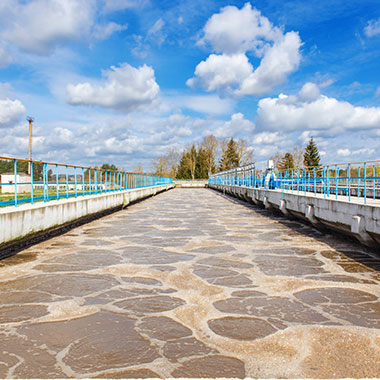
Surface Water, Blended Water and Ground Water
Nitrate is a regulated contaminant often found in agricultural areas due to the use of fertilizers. It is important to monitor nitrate levels in potentially contaminated source waters because treatment is difficult and may require reverse osmosis (RO) filtration. Similarly, it is important to monitor for nitrite because it may also be present in source waters and because during treatment, nitrite is oxidized to produce nitrate.
Groundwater, especially under the direct influence of surface waters (GWUDI), may contain compounds like nitrate that, while not necessarily harmful for human health at levels below MCL (10 mg/L), can provide treatment challenges to some systems (especially those using chlorine for the first time).

Drinking Water Treatment
It is important to monitor source water for nitrite as it may be present and will get oxidized during treatment to produce nitrate. Measuring both nitrite and nitrate in chloraminated tap water is crucial to detect onset and ongoing nitrification to take timely mitigation actions. Changes in nitrite concentrations in chloraminated drinking water distribution systems can be an early indication of nitrification. It is crucial to monitor nitrite and nitrate and keep their concentrations at regulated levels to protect public health.
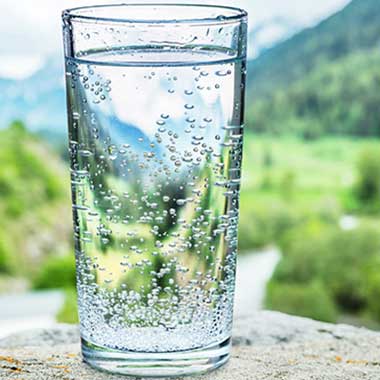
How Are Nitrate/Nitrite Levels Monitored and Managed?
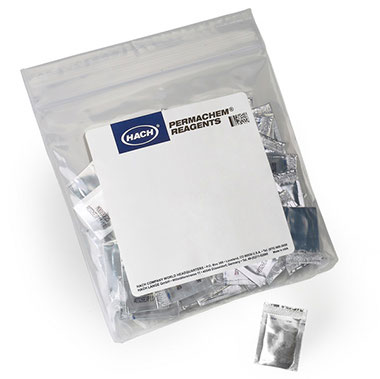
Ferrous Sulfate Method (Nitrite)
This method is predominantly used for wastewater. In an acidic medium, ferrous sulfate reduces nitrogen in nitrite (NO 2 -) to form nitrous oxide (NO). Ferrous ions combine with the nitrous oxide to form a brown-colored complexion, the color intensity of which is in direct proportion to the nitrite present in the water sample. Color development follows Beer’s Law.
Benchtop:
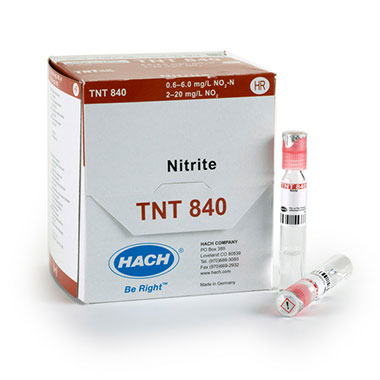
USEPA Diazotization Method (Nitrite)
In this low range nitrite test, nitrite ions react with sulfanilic acid to form an intermediate diazonium salt. This reacts with chronotropic acid to produce a red-orange complex directly proportional to the amount of nitrite present. A measurement of the color intensity then provides an accurate determination of the nitrite concentration in the water sample. This method can be used for wastewater, seawater, drinking water, surface water and process water.
Benchtop:
TNT841
Portable:
Online:
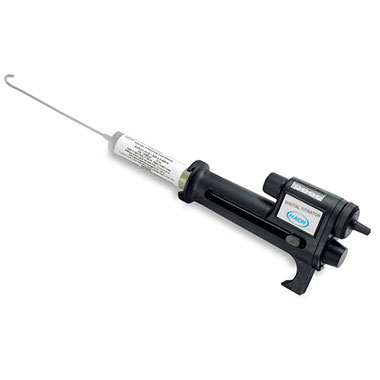
Ceric Acid Titration Method (Nitrite)
Ferroin indicator and acid are added to the sample. The sample is titrated with tetravalent cerium ion, which is a strong oxidant. After the cerium oxidizes the nitrite, the indicator is oxidized and causes a color change from orange to pale blue. The quantity of titrant used changes in relation to the concentration of sodium nitrite in the sample. This method is used for cooling tower waters.
Benchtop/portable:
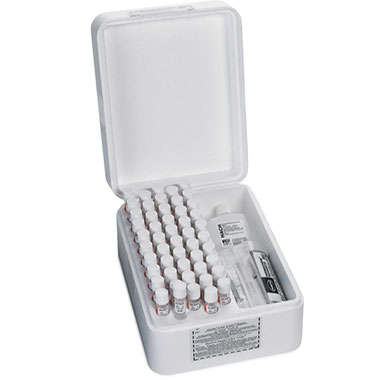
Chromotropic Acid Method (Nitrate)
Nitrate in the sample reacts with chromotropic acid under strongly acidic conditions to yield a yellow product that can be analyzed with a spectrophotometer or colorimeter. This method is used for wastewater.
Benchtop:
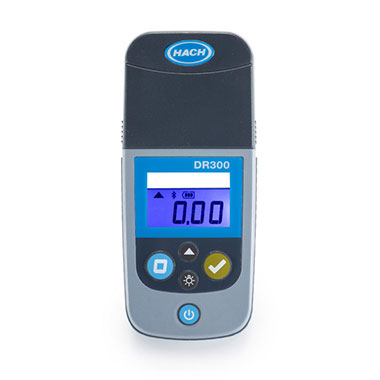
Cadmium Reduction Method (Nitrate/Nitrite)
In this colorimetric method, use for drinking water, wastewater and seawater, nitrate is reduced to nitrite with copper-plated cadmium particles. The diazonium reagents then react with the nitrite to produce a red color. The intensity of the color is proportional to the original amount of nitrate and nitrite present in the sample.
Benchtop:
Portable:
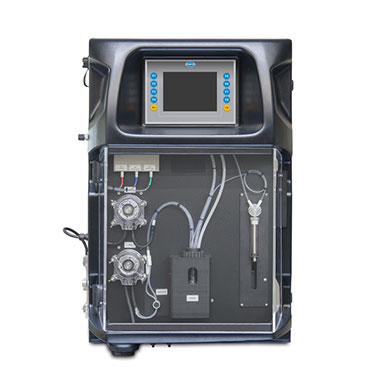
Hydrazine Reduction Method (Nitrate/Nitrite)
In this colorimetric method, use for drinking water, wastewater and seawater, nitrate is reduced to nitrite with hydrazine sulfate. The diazonium reagents then react with the nitrite to produce a red color. The intensity of the color is proportional to the original amount of nitrate and nitrite present in the sample.
Online:
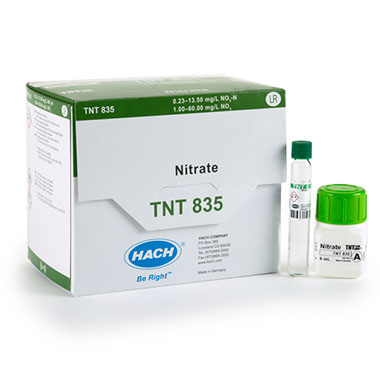
USEPA Dimethylphenol Method (Nitrate)
This method is used for wastewater, drinking water, surface water and process water. Nitrate ions in solutions that contain sulfuric and phosphoric acids react with 2,6- dimethylphenol to form 4-nitro-2,6-dimethylphenol, which can then be measured (wavelength 345 nm).
Benchtop:
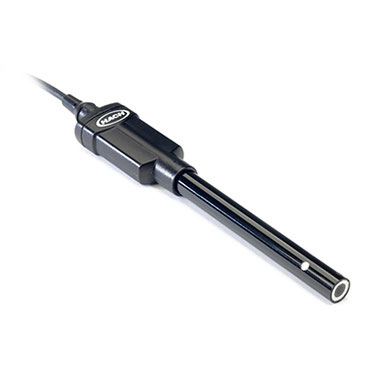
Direct ISE Method (Nitrate)
Nitrate ions are selectively absorbed by the ISE membrane. The absorbed nitrate ions cause a potential (voltage) that is proportional to the concentration of nitrate in the sample. The ISE membrane is a solvent-polymer membrane that is a nitrate ion-exchanger in an inert polyvinyl chloride (PVC) plastic matrix. The nitrate electrode has an internal silver/silver chloride element, which results in a fixed-reference potential when it touches the internal filling solution. This method is used for drinking water and wastewater.
Benchtop/portable:
Online:
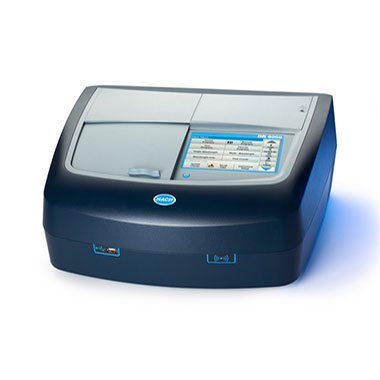
UV Screening Method (Nitrate)
The first measurement is done at 220 nm. Nitrate and organic matter absorb light at 220 nm. The second measurement is done at 275 nm. Nitrate does not absorb at 275 nm. The second measurement is used to correct the absorbance caused by the organic matter. Hydrochloric acid is added in the test procedure to prevent interference from hydroxide or carbonate ions. This method is not recommended for samples that contain high concentrations of organic matter, which would interfere with the test. Therefore, this method is used to screen uncontaminated natural and potable water supplies containing low concentrations of organic matter.
Benchtop:
DR6000 UV-VIS Spectrophotometer
Online:
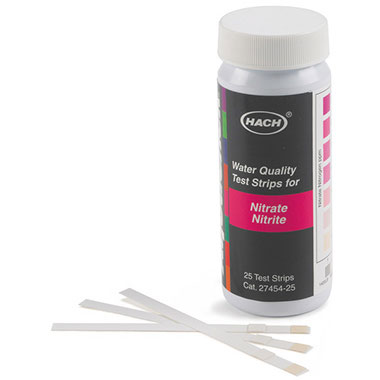
Nitrite & Nitrate Test Strips
The concentration range for nitrate is 0-50 mg/L in steps of 0, 1, 2, 5, 10, 20, and 50; and nitrite is 0-3 mg/L in steps of 0, 0.15, 0.3, 1, 1.5, and 3.
Frequently Asked Questions
How do you store the Nitrate ISE solid-state probes?
All solid-state electrodes should be stored dry and capped. All solid-state combination electrodes have an internal electrolyte that is limited and non-replaceable. Because of this storage method, any solution (even standard) can cause an accelerated and often excessive loss of electrolyte. This can significantly reduce the life of the electrode. Symptoms of excessive loss of electrolyte is a large offset, which can lead to calibration failure and longer stabilization time. During calibration, the later standards can have a longer stabilization time than the previous standards, which can cause those points to "lock-in" before the reading is stable. Prematurely locking in on the standard can cause slope issues and failed calibrations.
How to preserve the samples for nitrate/nitrite analysis?
The method for nitrate states that if preserved, samples are now total nitrate + nitrite. What does this mean?
Analyze the samples as soon as possible for the best results. If the immediate analysis is not possible, filter and keep the samples at or below 6°C or 42.8°F for a maximum of 48 hours. To preserve samples for a maximum of 28 days, adjust the pH to 2 or less with concentrated sulfuric acid (~ 2 mL per liter) and keep at or below 6°C or 42.8°F.
When preserving samples by acidifying with sulfuric acid, the nitrite in the sample is converted to nitrate. Because of this conversion, it becomes impossible to speciate the nitrite, even if the sample is neutralized before analysis. Samples requiring nitrite speciation should not be preserved.
Is the nitrate Test N Tube (TNTplus ®) Method 10206 approved by the Environmental Protection Agency (EPA)?
Method 10206 using the Nitrate TNTplus® Vial Test, LR (0.2-13.5 mg/L NO 3 -N) and Nitrate TNTplus ® Vial Test, HR (5-35 mg/L NO 3 -N); (Product # TNT835 and TNT836) is EPA approved for drinking water cited in the 40 Code of Federal Regulations (CFR) 141 and is approved for wastewater cited under 40 CFR 136 (Clean Water Act).
Is nitrite an interference in nitrate Method 10206 for TNT835 and TNT836?
Nitrite concentrations of more than 2.0 mg/L interfere (high-bias results) with nitrate method 10206 for TNT835 and TNT836. To account for this, add 50 mg of sulfamic acid (amid sulfonic acid) to 5.0 mL of sample, dissolve and wait for 10 minutes. Then analyze the prepared sample as described in the method.



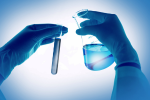

 Recurring Orders
Recurring Orders 
